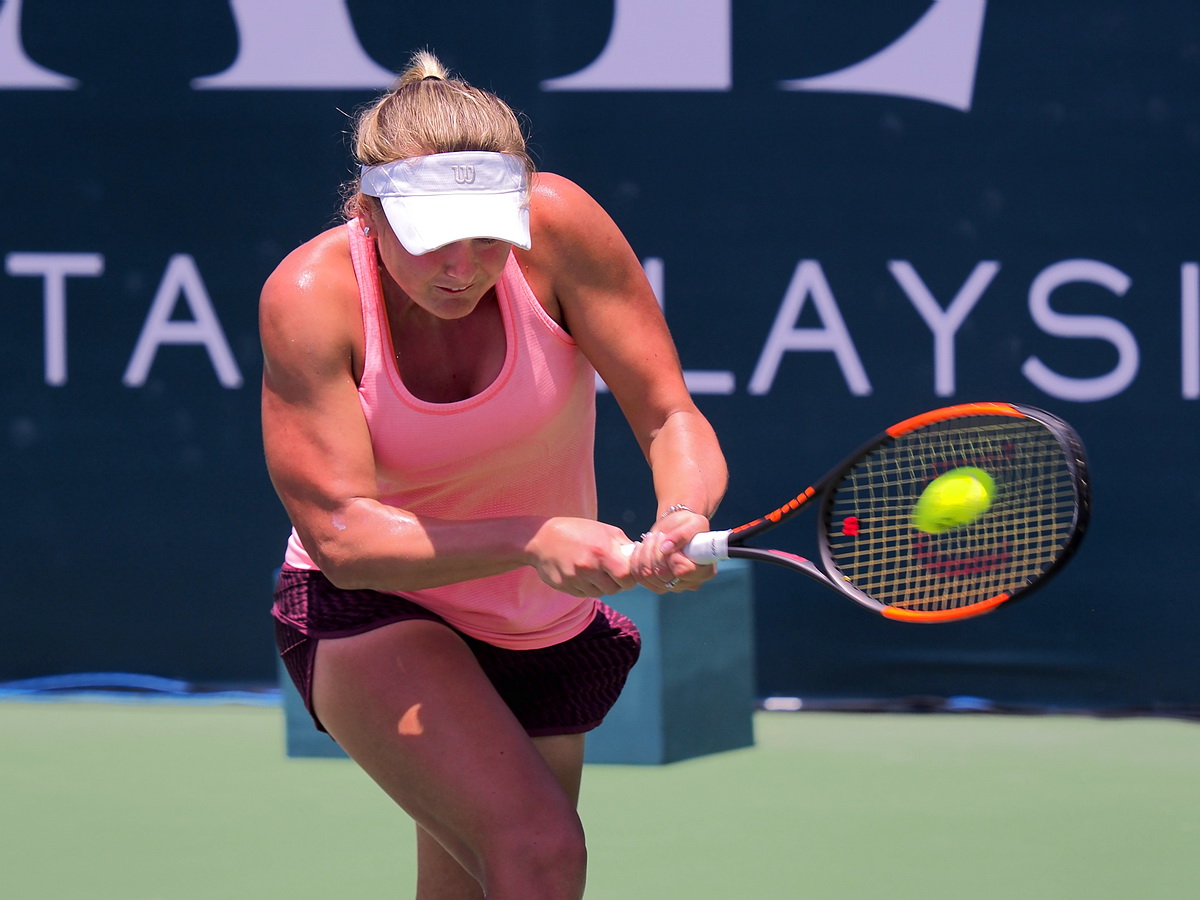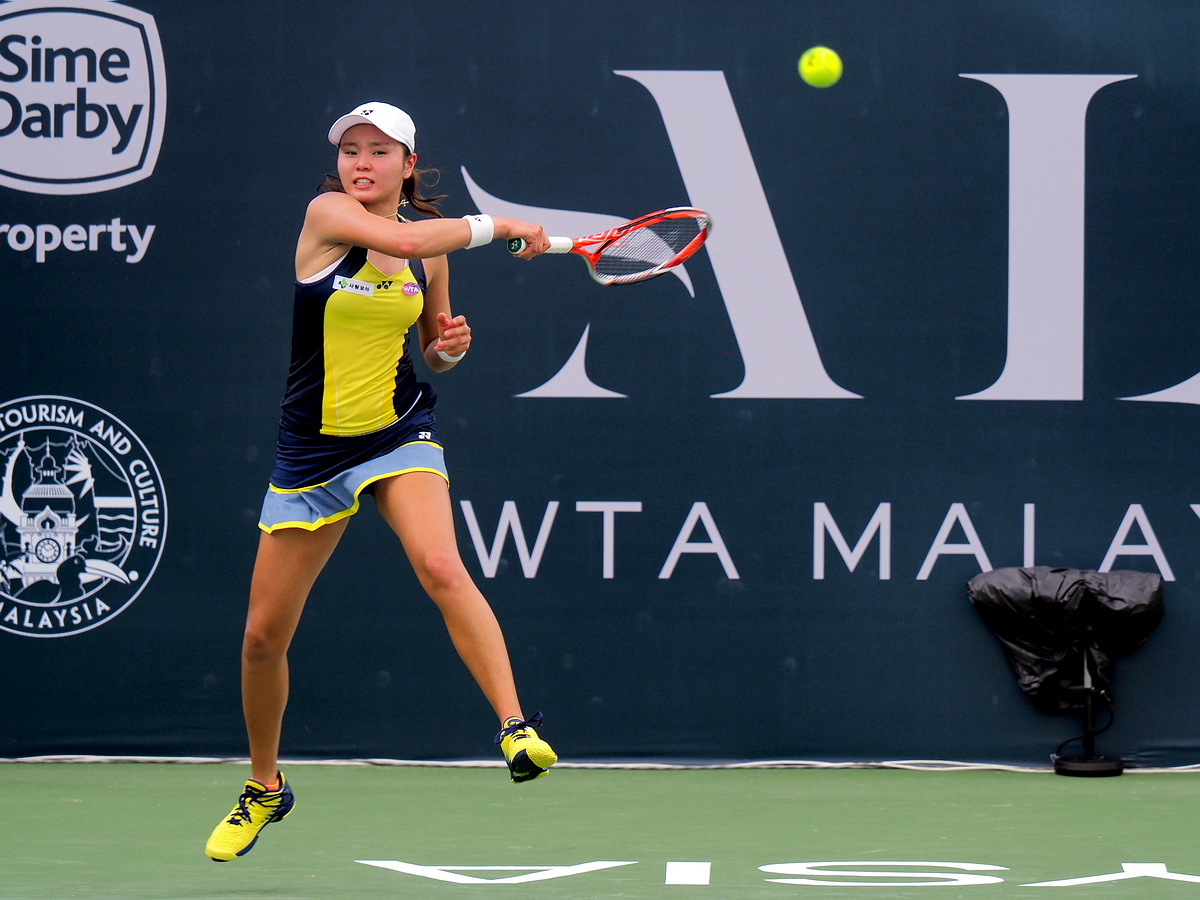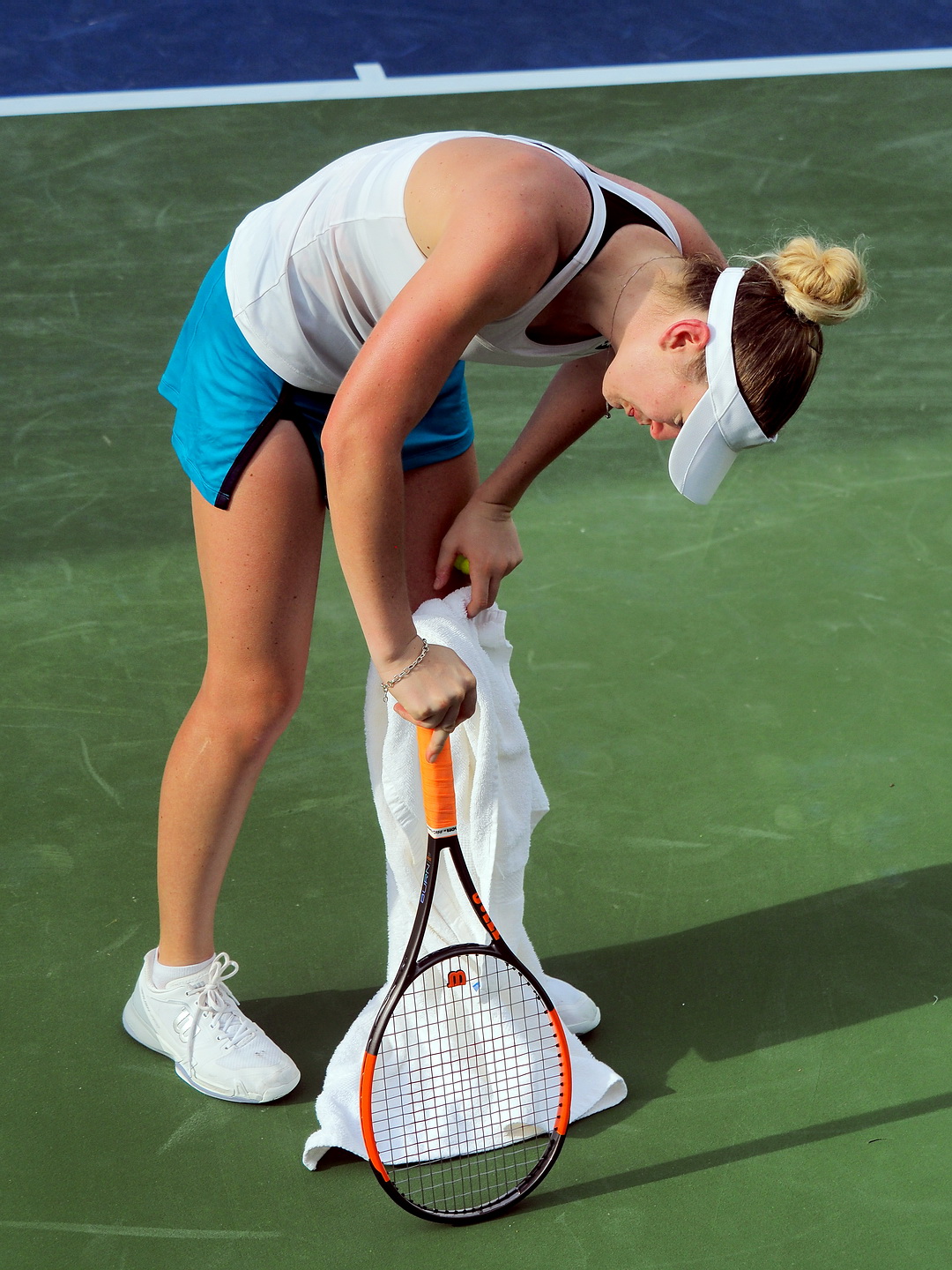Shooting ALYA WTA Malaysian Open 2017 With Olympus OM-D E-M10 Mark II and M.Zuiko 40-150mm F2.8 PRO Lens
It was a working Saturday for me, with a basic photography workshop conducted by me (if there is any chance the attendee of that workshop is visiting this page, thanks, and welcome!) and I was attending a friend's wedding in the evening, and that effectively left me only Sunday for shutter therapy. I wanted to do something differently, and Van suggested that we shoot an on-going ALYA WTA Malaysian Open at TPC, Kuala Lumpur, which was an official WTA tennis tournament. Being a tennis fan myself, and having the possibilities to try out my own Olympus OM-D E-M10 Mark II for sports shooting, I thought why not?
Surely, it was a Sunday, so the gang met up and took it slow, starting with overpriced coffee and filling our stomachs with good food, before we went under the gruesome grilling Malaysia sun for the rest of the afternoon. We went to a nice cafe, The Good Batch suggested by Robert and we had our brunch there, which was not too far from where the tennis tournament was. I had poached eggs and slices of salmon with some fancy dressing and like all ordinary Asians we spent way too much time photographing our food before we ate them.
Before I write down my thoughts and observations from this shoot, let me clarify that I am not a sports shooter, and I do not have enough experience to give meaningful advice for professional sports photography. I shall not pretend that I can do sports photography, and my conclusion is only based on this short 4 hours shooting session. I am writing from a photography enthusiast's point of view, someone who frequently shoots street photography (and sometimes landscape, portraits and insect macro) but would love to in rare occasions shoot sports, using own, available tools. Therefore, this blog entry is composed to explore the possibilities of using my E-M10 Mark II, as a hobbyist, and show what kind of photographs this camera can take in real life, sports events.
Here are the technical information from this particular tennis shooting session:
Aperture Priority - Set to the widest, F2.8 when using 40-150mm F2.8 lens alone, and F4 when using the MC-14 teleconverter.
ISO 200 when under direct harsh, sunlight, and when it got cloudy much later in the afternoon, ISO400 to maintain fast enough shutter speed.
Single-AF mode, with focusing point fixed at the center.
Burst Sequential continuous shooting, initially I used 11 frames per second (electronic shutter) and after seeing some strange distortion I used 8.5 frames per second (mechanical shutter)
Metering was set to Evaluative/Pattern with exposure compensation dialed down at -0.7 or -1.0 EV
I shot everything in RAW, came home with about 3500 images from a 4 hours shooting
I used the ECG-3 external grip on E-M10 Mark II at all time (MUST HAVE!!!)
I did not use Continuous AF, because, obviously, it will not do well enough to track the fast moving tennis players. However, most people underestimated the blazing speed of Single-AF, and the focusing can be locked on almost instantaneously when you half-press the shutter button. Taking advantage of this blistering speed (you got to use this to understand, just half-press and then quickly shoot), I can still get away with very high hit rate when I was shooting subjects in motion. I am not saying that this is good enough to substitute true potential of Continuous AF, I agree Continuous AF is needed for professionals to get the best possible shot. As I mentioned, I am not a professional, and honestly, that Single AF worked wonderfully well that I am able to show all these photographs taken in this blog entry!
The shooting with the E-M10 Mark II and 40-150mm F2.8 PRO lens was a revelation. People often complained that using the Electronic Viewfinder, there would be some lag between what is seen through EVF and real life. I experienced no such thing. I could effectively followed the actions and movements of the tennis players, quickly composed and executed my shots, with no noticeable delays. The shutter lag was minimal, and the camera reacted to my press of shutter button almost instantaneously. I performed short bursts (I did not hold down the shutter button for too long, maybe just for 2-3 seconds at one time), and everything went well efficiently. The camera operation was speedy and smooth, and I did not observe any issues at all during the shoot.
The biggest drawback of E-M10 Mark II, is probably the limited burst sequential shooting speed of 8.5 frames per second mechanical shutter. I tried using the 11 frames per second electronic shutter but got away with some weird distortions and warping. 8.5 frames per second is just not fast enough, and how I wish I had the 18 frames per second of E-M1 Mark II, or even 60 frames per second when shooting with Single-AF! It was no easy task to capture the tennis ball "sticking" on the tennis racket, or within the same frame as the tennis player. Once the burst of 8.5 frames per second started, I could only pray that one of the frames will successfully capture that perfect pose, or decisive shot.
Another technical limitation of E-M10 Mark II worth mentioning, is the maximum mechanical shutter speed of 1/4000sec. Under bright tropical sun, it was not fast enough to balance the exposure if I want to shoot with the widest aperture at F2.8, and I found that 1/8000sec is just nice. I did get some overexposed image, but still recoverable via RAW processing.
Now the big question: Am I happy with these shots I took at the Malaysian Open? Absolutely yes.
In fact the E-M10 Mark II performed above my expectations, and that could probably be also due to the amazing telephoto lens M.Zuiko 40-150mm F2.8 PRO. I managed to shoot many in-focus, perfectly sharp, action shots of the tennis players in action. I acknowledge that E-M10 Mark II is NOT the best camera for sports photography, we have established (in my extensive E-M1 Mark II review) that the new E-M1 Mark II is superior and has greater prowess for sports photography. That does not mean if you use lower level cameras you should feel inadequate or less confident in getting the shots. For hobbysts, you do not have a client and why do you worry or beat yourself up if you do not get the shots? Just go out and shoot and have more faith in your camera! Believe in yourself and you never know, these shots from less powerful cameras can actually be more meaningful to you at the end of the day, because you put more effort in them and you do your best to maximize the camera's potential!
One extremely important factor that ensures the success of sports photography, is to understand the game. I was a tennis player (I stopped playing about 8 years ago) and I followed the ATP and WTA tour updates religiously. Knowing the mechanics of the game can help you strategize your shots better. For example, most of time, before executing a backhand or forehand, the player will take a short pause (footing is extremely important) before taking a swing, and that momentary pause is the cue to lock my single-AF, before machine-gunning my shots subsequently. Predicting the movements of the players will also aid in anticipation on where the framing will be.

Are there any Micro Four Thirds shooters out there, using Olympus or Panasonic cameras for sports? Do share your experience, I want to hear from you!
The gear on the table
Surely, it was a Sunday, so the gang met up and took it slow, starting with overpriced coffee and filling our stomachs with good food, before we went under the gruesome grilling Malaysia sun for the rest of the afternoon. We went to a nice cafe, The Good Batch suggested by Robert and we had our brunch there, which was not too far from where the tennis tournament was. I had poached eggs and slices of salmon with some fancy dressing and like all ordinary Asians we spent way too much time photographing our food before we ate them.
Flat White
This plate is called Norwegian.
Sim's big breakfast platter with Robert's sexy looking OM-10
So why use E-M10 Mark II for tennis shooting?
Well, basically all the E-M1 Mark II cameras are out of the office at this moment, loaned to our dealers, photographers and media people. Also, I would like to challenge the popular perception that you need to use high end photography equipment to be able to shoot good sports photographs. You know, like the 1DX Mark II and D5, or at least the 7D Mark II or D500, and anything less, especially most camera options from the mirrorless are less superior and will not be able to sufficiently perform in serious sports photography. The main reason DSLR has an advantage is the use of phase-detect autofocus, which allows much better continuous focusing capabilities than contrast detect AF in most mirrorless cameras. Of course, there are exceptions, higher end mirrorless cameras such as Olympus OM-D E-M1 Mark II, Fujifilm X-T2 and Sony A6500 all have built in phase detect AF system for better continuous AF performance.
If you are a professional sports photographer, or earning money directly from sports and action photography, you should probably know what you are doing and have your own set of cameras and lenses. You have your own expectations when it comes to gear performance. However, how many of us are actually sports photographers? Like many of the readers who come to this blog, I myself, am a photo-enthusiast, not a professional photographer, and I rarely do shoot sports.Why should I be spending that much money for pure camera performance that I rarely need? Is it true that lower level DSLR or mirrorless cameras will not be able to deliver good enough results, even for the purpose of shooting just for the fun of shooting? How bad can modern cameras be that, after years and years of technological improvement, are there really bad cameras out there these days?
Therefore, I decided not to use E-M1 Mark II (ok ok, it was not available, I was making excuses, heh), or E-M1, and stayed with my humble E-M10 Mark II. E-M10 Mark II, E-M5 Mark II and PEN-F were criticized for not having good enough continuous focusing, and some websites can be cruel in pointing this out. I chose the M.Zuiko 40-150mm F2.8 PRO lens and tested the performance of this combo the whole Sunday afternoon, and I got sun-burnt for that.
Weapon of choice for the day, Olympus OM-D E-M10 Mark II and M.Zuiko 40-150mm F2.8 PRO lens
Dalila Jakupović
Anna Kalinskaya
Anna Kalinskaya
Before I write down my thoughts and observations from this shoot, let me clarify that I am not a sports shooter, and I do not have enough experience to give meaningful advice for professional sports photography. I shall not pretend that I can do sports photography, and my conclusion is only based on this short 4 hours shooting session. I am writing from a photography enthusiast's point of view, someone who frequently shoots street photography (and sometimes landscape, portraits and insect macro) but would love to in rare occasions shoot sports, using own, available tools. Therefore, this blog entry is composed to explore the possibilities of using my E-M10 Mark II, as a hobbyist, and show what kind of photographs this camera can take in real life, sports events.
Here are the technical information from this particular tennis shooting session:
Aperture Priority - Set to the widest, F2.8 when using 40-150mm F2.8 lens alone, and F4 when using the MC-14 teleconverter.
ISO 200 when under direct harsh, sunlight, and when it got cloudy much later in the afternoon, ISO400 to maintain fast enough shutter speed.
Single-AF mode, with focusing point fixed at the center.
Burst Sequential continuous shooting, initially I used 11 frames per second (electronic shutter) and after seeing some strange distortion I used 8.5 frames per second (mechanical shutter)
Metering was set to Evaluative/Pattern with exposure compensation dialed down at -0.7 or -1.0 EV
I shot everything in RAW, came home with about 3500 images from a 4 hours shooting
I used the ECG-3 external grip on E-M10 Mark II at all time (MUST HAVE!!!)
I did not use Continuous AF, because, obviously, it will not do well enough to track the fast moving tennis players. However, most people underestimated the blazing speed of Single-AF, and the focusing can be locked on almost instantaneously when you half-press the shutter button. Taking advantage of this blistering speed (you got to use this to understand, just half-press and then quickly shoot), I can still get away with very high hit rate when I was shooting subjects in motion. I am not saying that this is good enough to substitute true potential of Continuous AF, I agree Continuous AF is needed for professionals to get the best possible shot. As I mentioned, I am not a professional, and honestly, that Single AF worked wonderfully well that I am able to show all these photographs taken in this blog entry!
The shooting with the E-M10 Mark II and 40-150mm F2.8 PRO lens was a revelation. People often complained that using the Electronic Viewfinder, there would be some lag between what is seen through EVF and real life. I experienced no such thing. I could effectively followed the actions and movements of the tennis players, quickly composed and executed my shots, with no noticeable delays. The shutter lag was minimal, and the camera reacted to my press of shutter button almost instantaneously. I performed short bursts (I did not hold down the shutter button for too long, maybe just for 2-3 seconds at one time), and everything went well efficiently. The camera operation was speedy and smooth, and I did not observe any issues at all during the shoot.
The biggest drawback of E-M10 Mark II, is probably the limited burst sequential shooting speed of 8.5 frames per second mechanical shutter. I tried using the 11 frames per second electronic shutter but got away with some weird distortions and warping. 8.5 frames per second is just not fast enough, and how I wish I had the 18 frames per second of E-M1 Mark II, or even 60 frames per second when shooting with Single-AF! It was no easy task to capture the tennis ball "sticking" on the tennis racket, or within the same frame as the tennis player. Once the burst of 8.5 frames per second started, I could only pray that one of the frames will successfully capture that perfect pose, or decisive shot.
Another technical limitation of E-M10 Mark II worth mentioning, is the maximum mechanical shutter speed of 1/4000sec. Under bright tropical sun, it was not fast enough to balance the exposure if I want to shoot with the widest aperture at F2.8, and I found that 1/8000sec is just nice. I did get some overexposed image, but still recoverable via RAW processing.
Tereza Martincova
Tereza Martincova
Tereza Martincova
Tereza Martincova
Su Jeong Jang
Su Jeong Jang
Su Jeong Jang
Su Jeong Jang
Tereza Martincova
Tereza Martincova
Tereza Martincova
Su Jeong Jang
Now the big question: Am I happy with these shots I took at the Malaysian Open? Absolutely yes.
In fact the E-M10 Mark II performed above my expectations, and that could probably be also due to the amazing telephoto lens M.Zuiko 40-150mm F2.8 PRO. I managed to shoot many in-focus, perfectly sharp, action shots of the tennis players in action. I acknowledge that E-M10 Mark II is NOT the best camera for sports photography, we have established (in my extensive E-M1 Mark II review) that the new E-M1 Mark II is superior and has greater prowess for sports photography. That does not mean if you use lower level cameras you should feel inadequate or less confident in getting the shots. For hobbysts, you do not have a client and why do you worry or beat yourself up if you do not get the shots? Just go out and shoot and have more faith in your camera! Believe in yourself and you never know, these shots from less powerful cameras can actually be more meaningful to you at the end of the day, because you put more effort in them and you do your best to maximize the camera's potential!
One extremely important factor that ensures the success of sports photography, is to understand the game. I was a tennis player (I stopped playing about 8 years ago) and I followed the ATP and WTA tour updates religiously. Knowing the mechanics of the game can help you strategize your shots better. For example, most of time, before executing a backhand or forehand, the player will take a short pause (footing is extremely important) before taking a swing, and that momentary pause is the cue to lock my single-AF, before machine-gunning my shots subsequently. Predicting the movements of the players will also aid in anticipation on where the framing will be.
Su Jeong Jang
Tereza Martincova
Malaysian sun can be really punishing, if you are not conditioned for extremely humid and hot weather.
Su Jeong Jang
Su Jeong Jang
Tereza Martincova

Van Liguthom, Sim and Me
Are there any Micro Four Thirds shooters out there, using Olympus or Panasonic cameras for sports? Do share your experience, I want to hear from you!
Shooting ALYA WTA Malaysian Open 2017 With Olympus OM-D E-M10 Mark II and M.Zuiko 40-150mm F2.8 PRO Lens
 Reviewed by Unknown
on
February 26, 2017
Rating:
Reviewed by Unknown
on
February 26, 2017
Rating:
 Reviewed by Unknown
on
February 26, 2017
Rating:
Reviewed by Unknown
on
February 26, 2017
Rating:





































No comments: